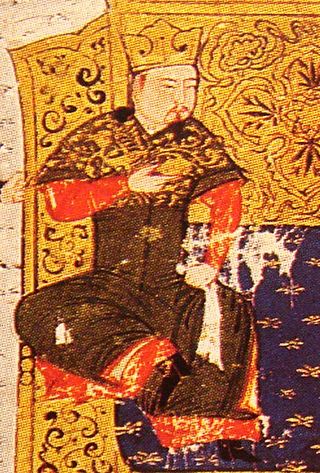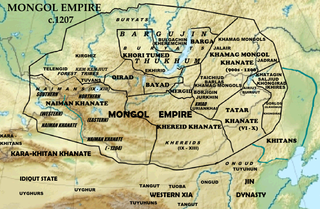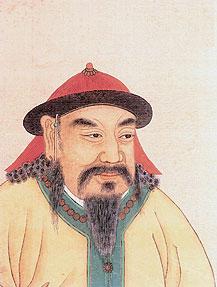Börte was the first wife of Temüjin, who became Genghis Khan, the founder of the Mongol Empire. Börte became the head of the first Court of Genghis Khan, and Grand Empress of his Empire. Little is known about the details of her early life, but she was betrothed to Genghis at a young age, married at seventeen, and then kidnapped by a rival tribe. Her husband's daring rescue of her may have been one of the key events that started him on his path to becoming a conqueror. She gave birth to four sons and five daughters, who, along with their own descendants, were the key bloodline that further expanded the Mongol Empire.

Ögedei Khan was the second ruler of the Mongol Empire. The third son of Genghis Khan, he continued the expansion of the empire that his father had begun.

Tolui was the youngest son of Genghis Khan and Börte. A prominent general during the early Mongol conquests, Tolui was a leading candidate to succeed his father after his death in 1227 and ultimately served as regent of the Mongol Empire until the accession of his brother Ögedei two years later. Tolui's wife was Sorghaghtani Beki; their sons included Möngke and Kublai, the fourth and fifth khagans of the empire, and Hulagu, the founder of the Ilkhanate.

Jochi Khan was a Mongol army commander who was the eldest son of Temüjin, and presumably one of the four sons by his principal wife Börte, though issues concerning his paternity followed him throughout his life. An accomplished military leader, he participated in his father's conquest of Central Asia, along with his brothers and uncles.

Töregene Khatun was the Great Khatun and regent of the Mongol Empire from the death of her husband Ögedei Khan in 1241 until the election of her eldest son Güyük Khan in 1246.

The Merkit was one of the five major tribal confederations (khanlig) of probably Mongol or Turkic origin in the 12th century Mongolian Plateau.

Hö'elün was a Mongolian noblewoman and the mother of Temüjin, better known as Genghis Khan. She played a major role in his rise to power, as described in The Secret History of the Mongols.

Sorghaghtani Beki or Bekhi, also written Sorkaktani, Sorkhokhtani, Sorkhogtani, Siyurkuktiti, posthumous name Empress Xianyi Zhuangsheng, was a Keraite princess and daughter-in-law of Genghis Khan. Married to Tolui, Genghis' youngest son, Sorghaghtani Beki became one of the most powerful and competent people in the Mongol Empire. She made policy decisions at a pivotal moment that led to the transition of the Mongol Empire towards a more cosmopolitan and sophisticated style of administration. She raised her sons to be leaders and maneuvered the family politics so that all four of her sons, Möngke Khan, Hulagu Khan, Ariq Böke, and Kublai Khan, went on to inherit the legacy of their grandfather.

Toghrul, also known as Wang Khan or Ong Khan, was a khan of the Keraites. He was the blood brother (anda) of the Mongol chief Yesugei and served as an important early patron and ally to Yesugei's son Temüjin, later known as Genghis Khan. The main source on his life is The Secret History of Mongols.
Jamukha was a Mongol military and political leader and the chief rival to Temüjin in the unification of the Mongol tribes.

Genghis Khan, also Chinggis Khan, was the founder and first khan of the Mongol Empire, which he ruled from 1206 until his death in 1227; it later became the largest contiguous empire in history. After spending most of his life uniting the Mongol tribes, he launched a series of military campaigns, conquering large parts of China and Central Asia.
Mongol campaigns in Central Asia occurred after the unification of the Mongol and Turkic tribes on the Mongolian plateau in 1206. Smaller military operations of the Mongol Empire in Central Asia included the destruction of surviving Merkit and Naimans and the conquest of Qara Khitai. These were followed by a major campaign against Khwarazm. Expansion into Central Asia began in 1209 as Genghis Khan sent an expedition to pursue rivals who had fled to the region and threatened his new empire. The Uyghur kingdom Qocho and leaders of the Karluks submitted voluntarily to the Mongol Empire and married into the imperial family. By 1218 the Mongols controlled all of Xinjiang and by 1221 all the territories of the former Khwarazmian Empire. In 1236, the Mongols defeated the eastern portions of Cumania and swept into Eastern Europe.
Bo'orchu was one of the first and most loyal of Genghis Khan's friends and allies. He first met Genghis Khan as a boy. At that time, Genghis Khan was looking for his stolen horses. Bo'orchu helped to win back the horses, and returned with Temujin to his father, Nakhu Bayan, who scolded him, having feared he was dead. Later, Temujin sent Hasar to get Bo'orchu and bring him to Temujin's camp. Bo'orchu refused any reward for helping Temujin to recover the stolen horses, but recognized his authority and attached to him as a nökör, leaving his own family.

Yesugei Baghatur or Yesükhei was a major chief of the Khamag Mongol confederation and the father of Temüjin, later known as Genghis Khan. He was from the Borjigin family, and his name means "like nine", meaning he had the auspicious qualities of the number nine, a lucky number to the Mongols.
Yesugen was one of the wives of Genghis Khan, the founder of the Mongol Empire. She was of Tatar ancestry. Her sister Yesui was also a wife of Genghis Khan. During his military campaign against the Tatars, Genghis Khan fell in love with Yesugen and took her in as a wife. She was, along with Yesui, the daughter of Yeke Cheren, a Tatar leader executed by the Mongol forces.
“Being loved by him, Yisügen Qatun said, ‘If it pleases the Qa’an, he will take care of me, regarding me as a human being and a person worth keeping. But my elder sister, who is called Yisüi, is superior to me: she is indeed fit for a ruler.’ ” -The Secret History of The Mongols

Tayang Khan — was a khan of the Naimans. According to The Secret History of the Mongols, he was physically weak when he was born and his father Inanch Bilge did not believe his son would survive to adulthood, therefore he was also called Torluq Tayang.
The rise of Genghis Khan involves the events from his birth as Temüjin in 1162 until 1206, when he was bestowed the title of "Genghis Khan", which means something along the lines of "Universal Ruler" or "Oceanic Ruler" by the Quriltai, which was an assembly of Mongol Chieftains.
Ibaqa Beki was a Kerait princess and Mongol khatun active in the early 13th century. She was briefly married to Genghis Khan, the founder of the Mongol Empire, and then subsequently married to the general Jürchedei.
Sochigel was either a junior wife or concubine of Yesügei, the chief of the Khamag Mongol confederation and father of Genghis Khan. Sochigel's children were Ghengis Khan's half-siblings, and included Behter and Belgutei; the latter became one of Genghis Khan's advisors.
The Battle of the Irtysh River or Battle Along the Buqdarma was a battle between the Mongol Empire and remnants of the Merkit and Naimans, fought at the junction of the Bukhtarma with the Irtysh in late 1208 or very early 1209. The Merkit had a longstanding rivalry with the Borjigin, the family of Genghis Khan, and together with the Naimans opposed Genghis Khan's rise to power. The Battle of Chakirmaut in 1204 shattered the forces of the Merkit-Naimans alliance and the survivors fled into southern Western Siberia. When Jochi, the son of Genghis, led an expedition into Siberia to subjugate what the Mongols called the "Forest Peoples", he encountered the remnant armies of the Merkits and Naimans at the Irtysh and soundly defeated them, shattering the alliance. The Merkit commander Toqto'a was slain and the Naiman leader Kuchlug fled.











